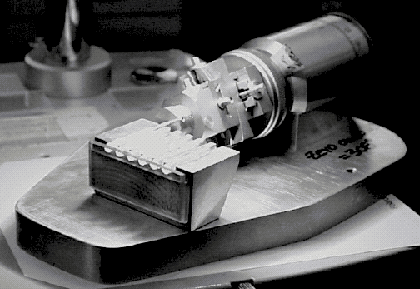

Last year, we reported on the successful generation of shear waves with near-optical wavelengths for GHz-frequency ultrasonic interferometry. The new acoustic technique for bench-top ultrasonics features a P-to-S wave conversion by reflection on the oriented facet of a single crystal MgO prism. The technology was put to use this year for determination of the complete set of ambient P-T elastic constants (c11, c12, c44) across the ferropericlase-magnesiowüstite (Mg,Fe)O solid solution. Our next objective is to modify the design for construction of a more durable conversion buffer rod made from single-crystal sapphire, shaped to work with the diamond anvil cell for shear wave measurements at high pressure and temperature. Here we report on our progress.
Whereas we could use the [100] pure-mode directions in MgO for the orthogonal conversion in the
bench-top prism, for the diamond cell we require a pointed buffer rod that
fits into the access cone for acoustical contact with the diamond-anvil
(Fig. 3.7-1). We have chosen to start with c-axis oriented sapphire
rods because the cylinder direction will then support pure-shear mode propagation.
We require the conversion to occur at 90° (for symmetrical return of
the strain wave), so the incident compression wave (from a transducer)
must be applied from the side of the cylinder. Only the a-axis or (11 0)
direction of sapphire supports pure-compressional mode propagation, so
we are polishing an a-axis flat on the side of buffer rod. We have
completed the orientation and transfer of six sapphire crystals to a polishing
platform for production of shear buffer rods (Fig. 3.7-2) using an X-ray
precession camera. Completion of the first flat and sputtering of the incident
P-wave transducer is expected to occur in early 2001.
0)
direction of sapphire supports pure-compressional mode propagation, so
we are polishing an a-axis flat on the side of buffer rod. We have
completed the orientation and transfer of six sapphire crystals to a polishing
platform for production of shear buffer rods (Fig. 3.7-2) using an X-ray
precession camera. Completion of the first flat and sputtering of the incident
P-wave transducer is expected to occur in early 2001.
 |
 |

Tel: +49-(0) 921 55 3700 / 3766, Fax: +49-(0) 921 55 3769, E-mail: bayerisches.geoinstitut(at)uni-bayreuth.de
 Previous page
Previous page